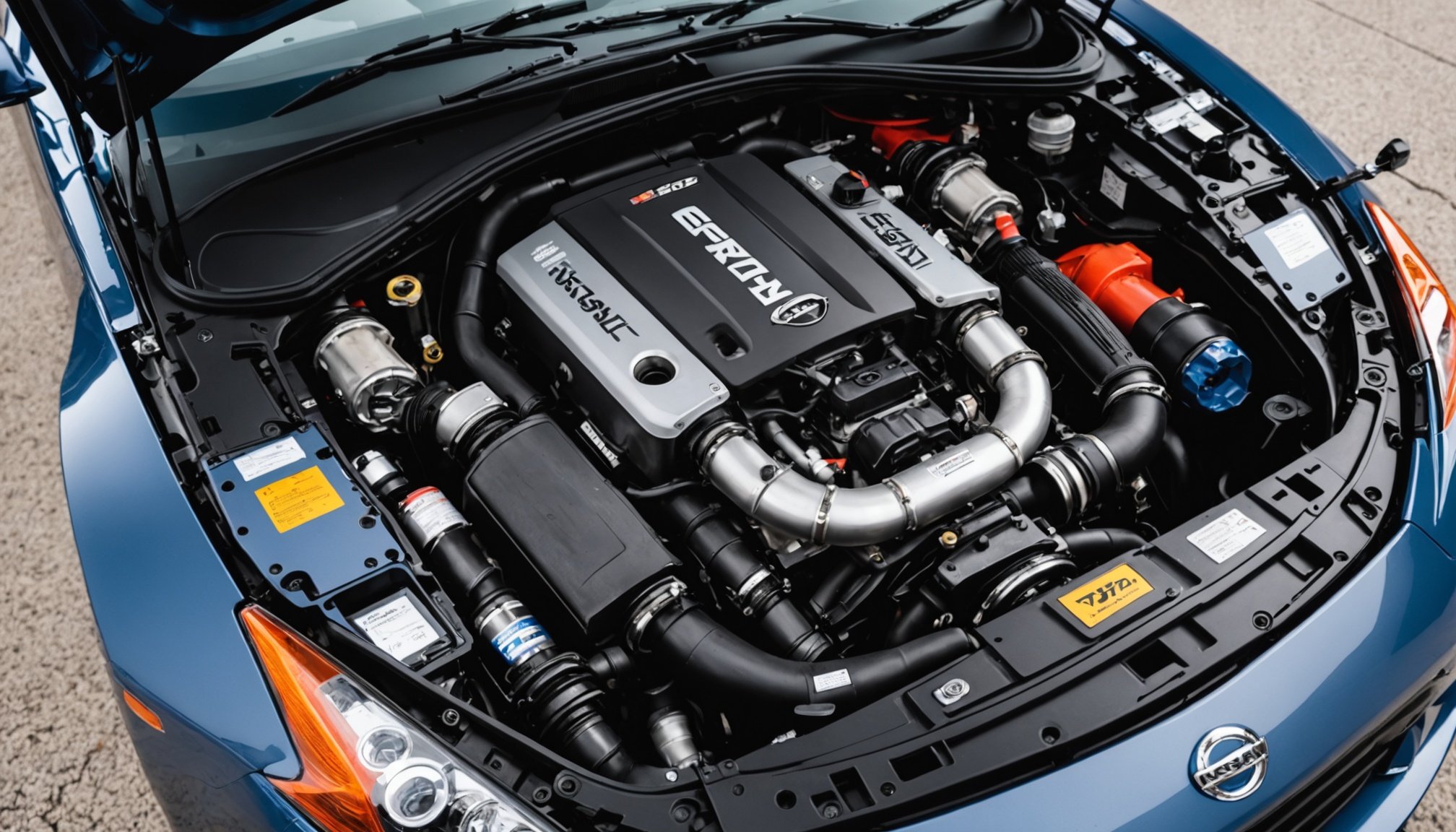Understanding Cold Air Intakes for the Nissan 370Z
Cold air intake systems are a popular modification among Nissan 370Z performance enthusiasts. These systems aim to enhance engine performance by redirecting cooler, denser air into the engine, beneficially impacting power output and efficiency.
How Cold Air Intakes Function
A cold air intake works by positioning the air filter outside the engine compartment, typically in a wheel well or by the bumper, to draw in cooler ambient air. This modification contrasts with factory air intake systems that often draw in warmer air from the engine bay, which is less efficient due to lower air density.
Also to discover : Essential handbook for boosting horsepower: installing a turbocharger on your honda s2000
Comparing to Factory Intake Systems
The factory intake systems in a Nissan 370Z are designed for cost-effectiveness and noise reduction, not necessarily performance. In contrast, cold air intakes aim to optimise the airflow and air quality reaching the engine. This leads to a potential increase in power, thanks to the enhanced combustion process that cooler air promotes.
Importance of Air Temperature
The temperature of the incoming air is a critical factor in engine performance. Cooler air is denser, meaning it carries more oxygen, which improves combustion efficiency. The result? Enhanced performance characterized by better throttle response and potentially increased horsepower. Overall, this upgrade can be significant for those seeking more from their Nissan 370Z.
In the same genre : Enhance your toyota celica”s brake performance: the ultimate guide to upgrading front calipers for superior stopping power
Benefits of Cold Air Intakes
Cold air intakes offer a range of benefits, particularly for those seeking to enhance the performance of their Nissan 370Z. One of the most notable advantages is the potential increase in horsepower. By drawing in cooler air, these systems promote better combustion, which can lead to power gains. Depending on the brand and model, users can experience noticeable improvements in power output.
In addition to horsepower boosts, these intakes can also enhance torque. This enhancement means quicker acceleration and more robust performance, particularly when navigating demanding driving conditions. Improved throttle response is another key benefit, making the vehicle feel more responsive and connected to driver inputs.
Moreover, there are efficiency gains to consider. Enhanced fuel efficiency is often reported, with drivers noticing better mileage and overall economy. This is mainly due to the improved air intake systems promoting a more complete combustion process, thereby utilising less fuel for the same output.
Consequently, upgrading to a cold air intake system could be a strategic move for Nissan 370Z owners looking to enhance performance, improve efficiency, and enjoy a more dynamic driving experience.
Performance Data and Testing Results
Performance testing of cold air intakes on the Nissan 370Z reveals tangible results that intrigue performance enthusiasts. Cold air intake results demonstrated in various testing scenarios echo claims of enhanced performance. Notably, Nissan 370Z dyno tests are a common method to empirically assess performance changes post-installation.
In numerous real-world testing scenarios, cold air intake models have shown an increase in horsepower and torque, providing a more engaging driving experience. Dyno tests frequently illustrate improvements in both peak and average power, highlighting the impact of cooler, denser air on the vehicle’s performance envelope.
Such performance testing does not only focus on numbers but also evaluates the overall driving dynamics. Improved throttle response and increased acceleration are observed in line with expectations tied to enhanced combustion efficiency.
However, it is essential to consider the variability in performance outcomes, which can stem from differences in intake design and environmental conditions during testing. Data analysis confirms that while some enthusiasts report noticeable improvements, others may perceive less dramatic changes, underscoring the importance of choosing the right cold air intake model for optimal results.
Installation Guide for Cold Air Intakes
Installing a cold air intake on your Nissan 370Z offers a fulfilling DIY experience and enhances performance. Here’s a clear roadmap for a successful installation.
Step-by-Step Instructions
- Gather Necessary Tools: You’ll need basic tools such as screwdrivers, ratchets, and pliers.
- Remove Factory Intake: Begin by carefully detaching the factory air intake system. Ensure all clamps and hoses are removed gently.
- Position New Intake: Place the new cold air intake into the designated spot, often requiring use of the previous mounting points.
- Secure Connections: Fasten clamps and ensure all connections are tight to prevent air leaks.
- Reattach Sensors: Any air sensors should be securely connected to the new system.
- Test the System: Once installed, start the engine and listen for any irregular sounds indicating loose fittings.
Common Pitfalls
During the process, avoid overtightening clamps, as this can damage components. Pay attention to sensor placements—incorrect positions may affect engine performance. If you experience power fluctuations or unusual noises, recheck all fittings and connections.
This thorough approach ensures a seamless integration of the cold air intake, fostering optimum Nissan 370Z performance.
Potential Drawbacks of Cold Air Intakes
While cold air intakes offer numerous benefits, it’s crucial to understand potential drawbacks associated with such Nissan 370Z modifications. One significant concern revolves around the risks of engine tuning difficulties after installation. If not tuned properly, the engine may not perform optimally, potentially resulting in diminished power gains or erratic throttle response.
Another potential issue is the risk of water ingestion in environments where the filter’s proximity to moisture is heightened, like driving through deep puddles. Water entering the engine can lead to hydrolock, causing severe damage and costly repairs.
Variability in performance outcomes is another factor to consider, as cold air intake design plays a critical role. Some designs may not align well with every driving style or environmental condition, leading to inconsistent results. Thus, selecting a well-reviewed intake suited to specific requirements is essential to avoid these pitfalls.
Understanding these potential performance issues allows Nissan 370Z owners to make informed decisions about whether the modifications meet their priorities and driving conditions effectively.
User Testimonials and Expert Opinions
When researching cold air intakes for the Nissan 370Z, insights from user reviews and expert analysis can be invaluable. The general consensus in Nissan 370Z forums highlights the tangible improvements seen in performance after installation. Many users have noticed significant horsepower increase and improved torque enhancement, resulting in a more exhilarating driving experience.
This shift in performance is often echoed by experts, whose analysis underscores the advantages of a superior air intake system. Experts also warn, however, of the potential pitfalls if systems are not carefully selected or installed. The variability in experiences shows the necessity of ensuring the right match between a specific cold air intake and your driving style.
Case studies bring these experiences to life, illustrating how different cold air intake configurations positively or negatively impacted performance outcomes for diverse users. One notable case illustrates a user’s journey with a cold air intake installation, resulting in a noticeable boost in engine responsiveness and throttle response after proper tuning. Such narratives provide a more comprehensive understanding of the potential benefits and risks, helping individuals make informed decisions about their Nissan 370Z modifications.
Visual Aids and Further Resources
Utilising visual aids enhances understanding when exploring cold air intakes and their impact on Nissan 370Z performance. Several recommended instructional videos demonstrate the installation steps and performance changes, making processes more accessible to enthusiasts and owners.
Infographics serve as valuable tools, illustrating the horsepower increase and torque enhancement achieved through upgrading. Such visuals compare metrics pre- and post-installation, providing a clear picture of the gains.
For those interested in a deeper dive, well-produced videos guide users through the nuances of optimal settings, offering insights into air intake systems and their influence on engine dynamics. These resources are especially beneficial for those considering DIY installations or needing troubleshooting advice.
Furthermore, it is advisable to refer to reputable product retailers and brands for purchasing guidance. Engaging with recommended vendors ensures authenticity and quality, contributing to the long-term success of the modification. Being informed about product sources allows for better investment decisions and peace of mind when implementing Nissan 370Z modifications.
Overall, integrating visual aids with technical knowledge enables owners to maximise the outcomes of their cold air intake enhancements, supporting a more enjoyable and dynamic driving experience.











